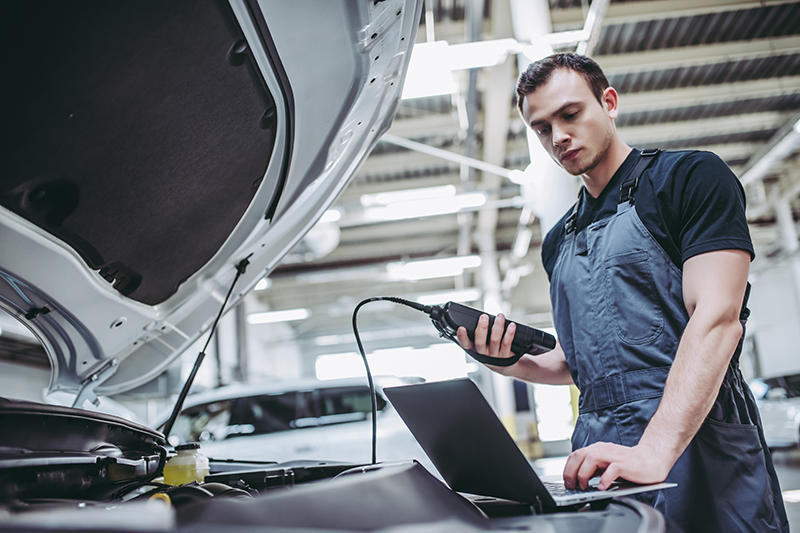Industry insights on skills needs
Consistent change and evolution of technology in the Automotive industry means the technical skills required to keep pace are a key focus for the sector. Industry consultation and previous research, as highlighted in the Automotive IRC’s 2019 Skills Forecast, identifies significant skills demand in the industry for the following:
- Fault diagnosis skills
- Mechanical and electrical repair skills for modern vehicle systems, including semi-automatic driving technologies like:
- Park assist
- Lane departure warning
- Autonomous emergency braking.
The Automotive IRC’s 2019 Skills Forecast identifies three key opportunities and challenges for employers and learners in the industry, including:
- Outdated public perceptions discourage enrolments: Industry feedback has suggested that outdated perceptions among learners and misinformed career advisors that industry job roles are highly manual, labour intensive and not requiring high order thinking is affecting the supply of quality learners. These perceptions have become increasingly untrue over the past ten years with the growing complexity of motor vehicles, components and diagnostic tools, along with tighter regulatory standards for service and repair work.
- Employer dissatisfaction with diagnostic skills training: Presently, inconsistent diagnostic skills among graduates who have completed certificate III level qualifications are being reported by employers. This presents the opportunity for the Training Package to increase its focus on building and developing these skills in learners.
- AUR learners benefit from high levels of full-time employment: Recent survey data suggests 83.5% of AUR Training Package graduates were in employment by May 2018 as opposed to 44.1% of all VET graduates. This strong learner and employer engagement presents opportunities for the Training Package.
In addition, three key drivers have been uncovered in the Automotive IRC’s 2019 Skills Forecast as underpinning long-term change in Australia’s Automotive industry. These drivers for change are identified as an evolving economic environment, changing technology and shifting consumer preferences.
The evolving economic environment covers a range of factors affecting small businesses, including increased equipment costs due to ever changing technology, difficulty accessing technical repair information due to a reluctance among dealerships to share important product documentation, and prevailing skills shortages. Another economic factor is increased activity from key users of commercial vehicles, such as construction and mining, leading to forecasted strong jobs and skills demand in heavy vehicle-related sectors over the coming years.
Some of the key areas being impacted by changing technology in the industry include motor vehicles becoming increasingly complex as their share of electronic components increases, therefore leading to more sophisticated service and repair roles, while relationships with suppliers and customers are becoming more digital. Each of these factors leads to a need to ensure workers and learners are adequately skilled, re-skilled and up-skilled so they can remain up to date with the latest motor vehicle technology.
Shifting consumer preferences have led to an increased demand for larger, greener and more fuel-efficient cars, increasing use of a greater variety of transport options such as car-sharing and ridesharing services, and a decrease in vehicle servicing requirements coupled with increasing competition within the industry. Skill sets must evolve along with consumer preferences so that technicians are able to diagnose, service and repair all types of vehicles on the road, as well as increasing commercial acumen and relationship management skills in order to be successful in the increasingly competitive vehicle service and repair market.
Modelling included in the Victorian Automobile Chamber of Commerce (VACC) submission Recommended JobTrainer Fund Qualifications estimates skills shortages in 20 occupations equating to 31,012 positions within the Automotive industry. Key factors driving these shortages include contributing to the high number of skill shortages experienced within the Automotive Industry include that the number of vehicles on-road in Australia is growing while annual apprentice commencements in automotive trades have fallen over the decade (which were roughly 14,030 in 2010 and 11,560 for 2019), the transition to hybrid, electric and fuel cell/hydrogen vehicle technologies has placed new and increased skills demands on automotive businesses, and the widening of the gap between available skilled labour and the needs of the automotive industry due to the sharp, COVID driven, reduction in international skilled labour being available to employers (see more information on this in the COVID-19 impact section).
The sector pages provide more information for individual sectors.


